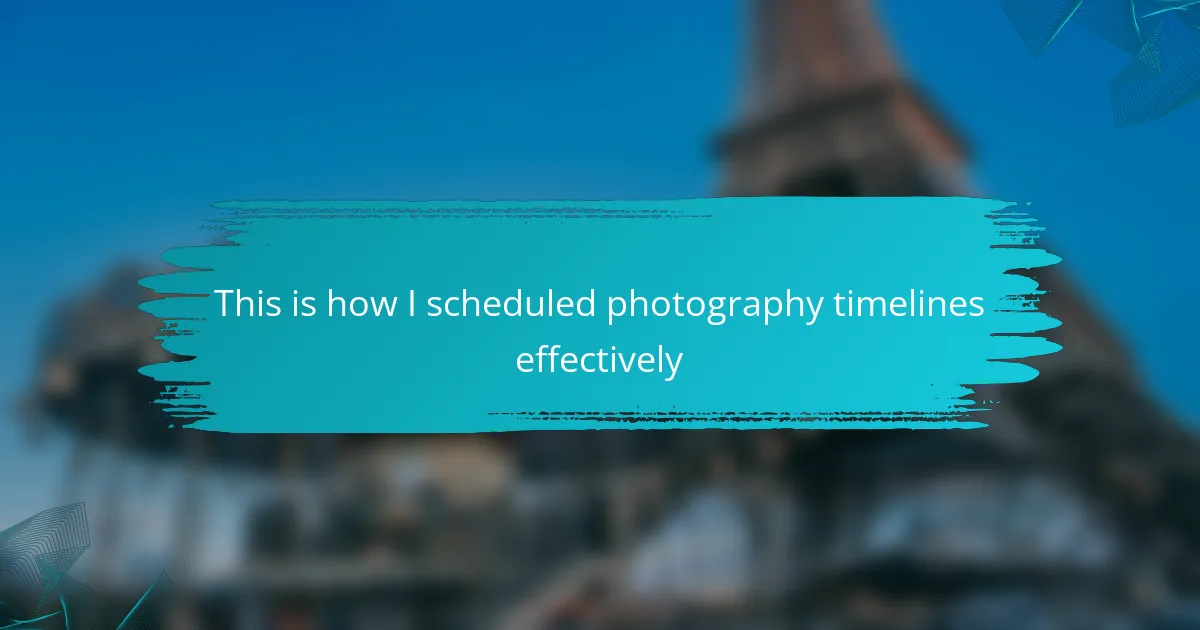Key takeaways
- Creating a structured wedding photography timeline is essential for capturing key moments and reducing stress for couples.
- Key elements include communication with the couple, location scouting, flexibility, and coordination with other vendors.
- Buffer time is crucial to accommodate unexpected delays and ensure all important shots are captured.
- Adaptability and calmness during unforeseen challenges can lead to beautiful, spontaneous moments in photography.
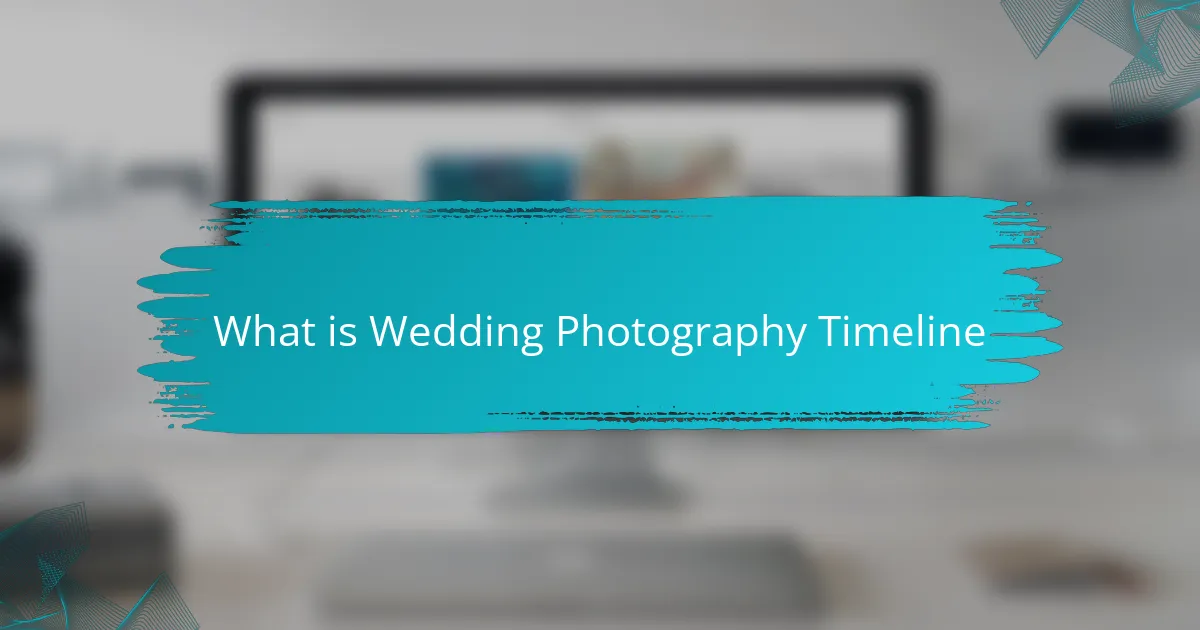
What is Wedding Photography Timeline
Wedding photography timelines are crucial for capturing every essential moment of a couple’s big day. From the pre-ceremony preparations to the final dance at the reception, a well-structured timeline ensures that photographers can effectively document each phase without missing any important shots. Reflecting on my own experience, I’ve seen how a clearly defined timeline not only keeps the day flowing smoothly but also helps alleviate stress for everyone involved.
Creating a photography timeline is like crafting a beautiful story. It involves thoughtful planning and coordination with the couple, wedding planner, and other vendors. I remember a wedding where the timeline was off, and we rushed through family portraits. It taught me the importance of precision in scheduling, allowing us to focus on heartfelt moments instead.
Here’s a simple comparison table that illustrates some key components of a wedding photography timeline:
| Timeline Component | Importance |
|---|---|
| Getting Ready | Captures candid moments of the bride and groom before the ceremony. |
| Ceremony | Essential for documenting vows, emotions, and the first kiss. |
| Reception | Key for showcasing the celebration, toasts, and first dances. |
| Family Portraits | Helps to ensure all family members are photographed together. |
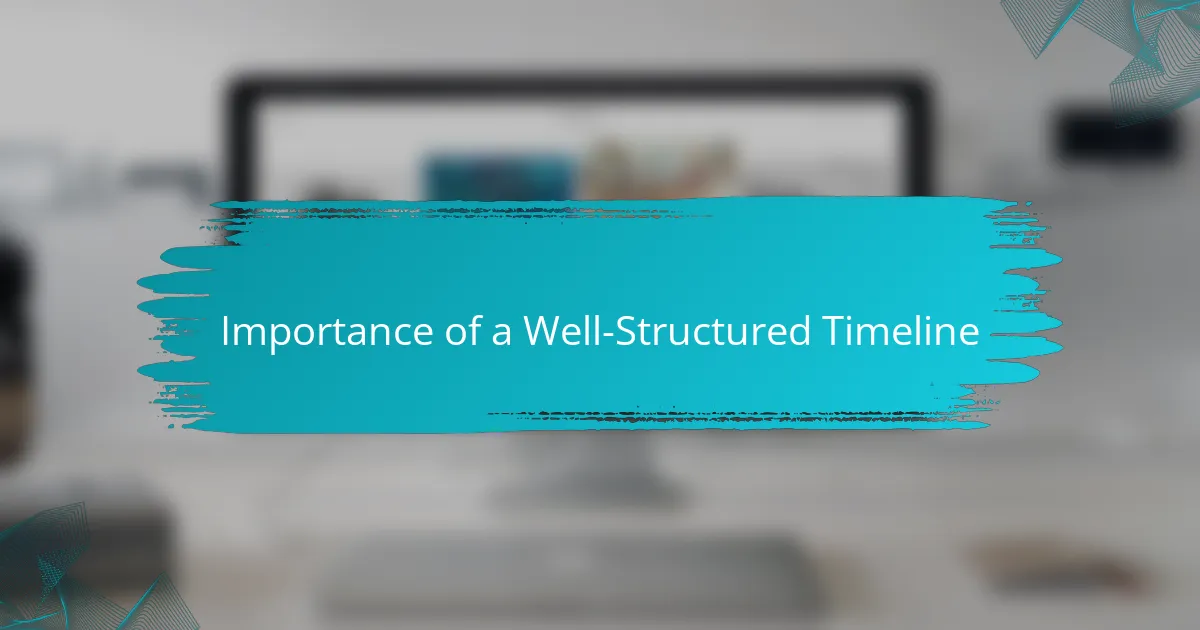
Importance of a Well-Structured Timeline
A well-structured timeline is crucial for any wedding photography shoot, as it ensures that all moments are captured without stress. I’ve experienced firsthand how a clear timeline can alleviate chaos on what is often a whirlwind day. When every segment of the day has a dedicated time, couples can relax and enjoy their day, knowing that no precious moments will be missed.
When I worked on a wedding where the timeline was meticulously planned, the flow of the day felt seamless. There was time for candid shots, formal portraits, and even those spontaneous moments that make photography truly magical. In contrast, I remember a wedding that lacked a structured schedule; it felt rushed, and some beautiful opportunities slipped away.
| Well-Structured Timeline | Lack of Timeline |
|---|---|
| Reduces stress for the couple | Creates confusion and panic |
| Ensures key moments are captured | May miss important shots |
| Promotes a smooth flow of events | Results in disorganization |
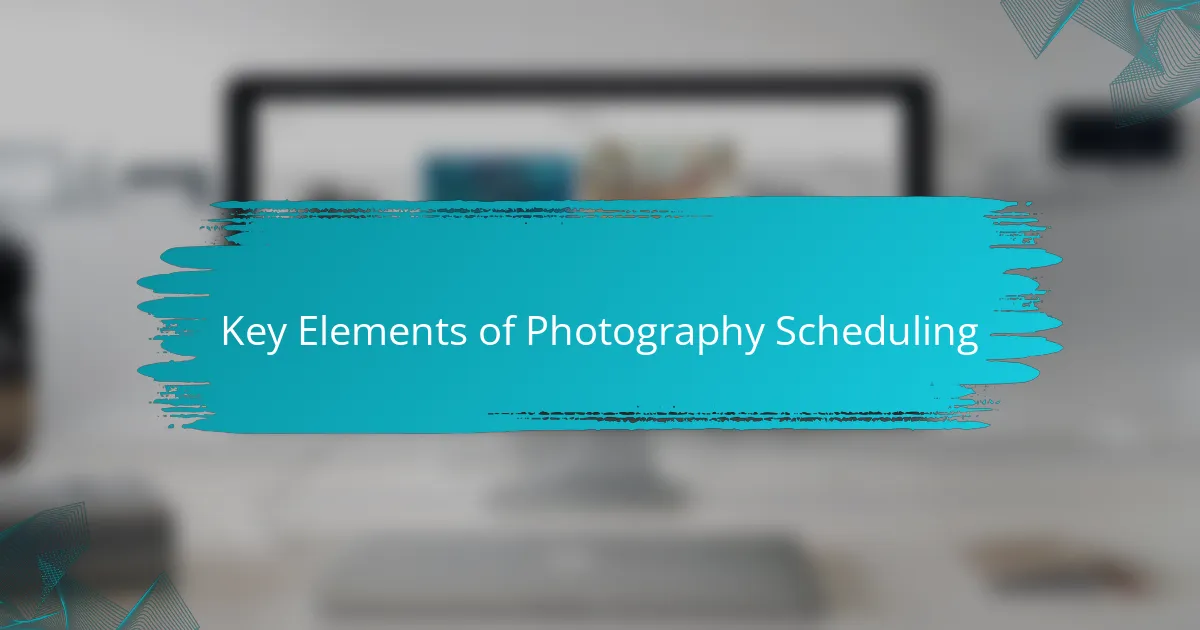
Key Elements of Photography Scheduling
When scheduling a wedding photography timeline, there are a few key elements that I always keep in mind. First, communication with the couple is vital. I make it a point to listen to their priorities and any must-have shots they envision. Understanding these details allows me to craft a timeline that aligns perfectly with their dream day.
Another crucial element is location. I’ve found that scouting venues ahead of time not only helps in planning for lighting but also allows me to identify potential backdrops that can make those special moments even more beautiful. Having a flexible schedule is also important; sometimes the day takes unexpected turns, and being adaptable can make all the difference in capturing those candid moments.
It’s also worth noting how essential it is to work closely with other vendors. I’ve learned that coordinating with the wedding planner or coordinating directly with the couple ensures that everything runs smoothly. This collaborative effort elevates the overall experience and makes for stunning photos.
| Key Element | Description |
|---|---|
| Communication | Discuss priorities and must-have shots with the couple. |
| Location Scouting | Familiarize yourself with the venue for optimal backlighting and composition. |
| Flexibility | Be prepared to adjust the timeline as the day unfolds. |
| Vendor Coordination | Collaborate with other vendors to ensure a seamless experience. |
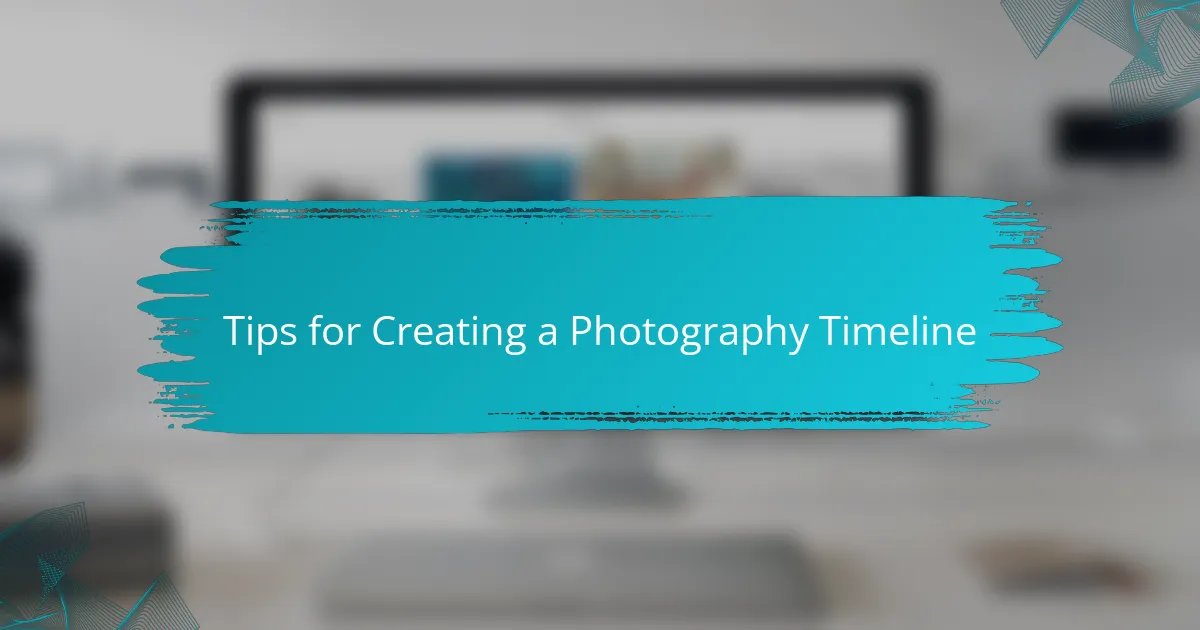
Tips for Creating a Photography Timeline
I believe the key to a successful photography timeline is all in the details. During one wedding, I took the time to sit down with the couple to discuss their favorite moments and any specific shots they really wanted. This personal touch helped me tailor the timeline to their unique vision, and the end result was a beautifully documented day that truly reflected their love story.
It’s important to allow adequate time for each segment of the wedding day. I remember a couple who allocated just 20 minutes for family portraits. It felt rushed, and we missed capturing some cherished expressions. Giving yourself enough time means you’ll not only get the essential shots but also those candid interactions that bring the album to life.
Lastly, don’t forget to factor in some buffer time throughout the day. Things happen—whether it’s a late arrival or an unexpected but beautiful photo op. I always advise couples to build in a little extra time, and I can tell you, from experience, it makes a world of difference in capturing those genuine moments that unfold when no one’s watching. How often have you found those fleeting moments can be the most precious? They’re usually the ones that tell the best stories!

Personal Experiences with Timeline Challenges
When I first started in wedding photography, I encountered a major challenge with timeline management. I remember one beautiful summer day, the timeline was already behind schedule because of a 45-minute delay with the bride’s hair and makeup. I felt the pressure mounting as the sun began to set, and I quickly realized how crucial it is to have clear communication with the couple and their vendors.
There have been moments when I’ve been able to turn things around with a flexible approach. For instance, I once had a wedding planner who was brilliant at improvising. They reshuffled the ceremony spots to buy us extra time for a stunning sunset shoot, and it resulted in some of the most breathtaking photos I’ve ever captured. These experiences have taught me the importance of adaptability in planning a photographic timeline.
Here are some common challenges I’ve faced with wedding timelines:
- Communication Gaps: Misunderstandings about timing between couples, planners, and vendors.
- Unexpected Delays: Hair and makeup, traffic, or last-minute changes that push the schedule back.
- Weather Issues: Rain or unexpected shifts in lighting conditions that affect planned shots.
- Overambitious Schedules: Trying to fit too many locations or poses within a limited timeframe.
- Emotional Moments: Unforeseen moments of joy or tears that draw people away from planned events.
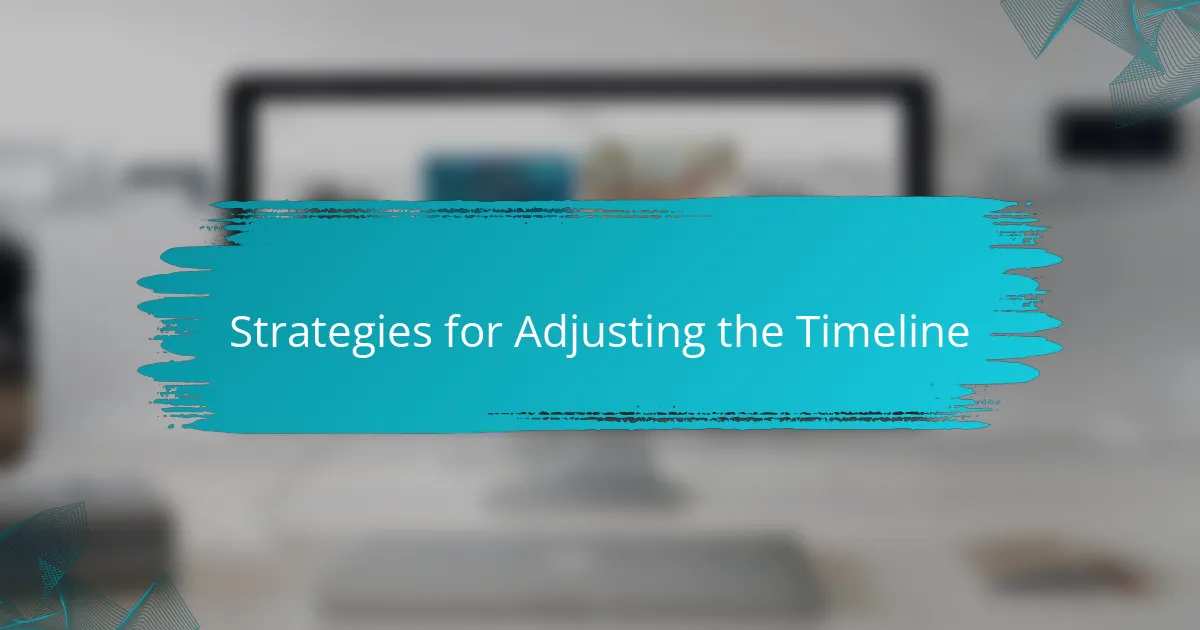
Strategies for Adjusting the Timeline
When it comes to adjusting the timeline, flexibility is key. I’ve learned that unforeseen circumstances, like tardy vendors or weather changes, can throw off even the best-laid plans. During one wedding shoot, a sudden downpour forced us to shuffle outdoor portraits into the reception area. Fortunately, quick thinking and a backup plan allowed us to capture beautiful, intimate moments under the twinkling fairy lights.
Here are some strategies I rely on for effectively adjusting the timeline during weddings:
-
Build in Buffer Time: I always include extra time between events. This way, if something runs late, we have wiggle room without the stress.
-
Communicate with Vendors: Keeping an open line with all vendors helps me anticipate any delays or changes, allowing for smoother adjustments.
-
Prioritize Key Moments: I make sure to identify the most important shots. If time gets tight, I know which moments to focus on first.
-
Adapt to Couples’ Needs: I take the couple’s preferences into account. If they want to spend more time with family, I can adjust other parts of the schedule to accommodate that.
-
Stay Calm: Maintaining a positive and calm demeanor reassures everyone involved. I find that my attitude can influence the mood of the entire day.
